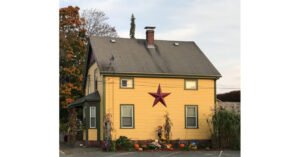Ever Noticed a Star on a Barn? Here’s What It Really Means
If you enjoy country life or just like taking walks away from busy cities, you may have noticed barn stars. These stars are often found above barn doors, either painted on or made of metal, and they serve as interesting decorations with a rich history.
But what do barn stars really mean? Where do they come from? If you’ve ever wondered about this, you’re in the right place. This article will explain a bit about barn stars and might even teach you something new.
The history of barn stars goes back over a hundred years, although there is some debate about their original purpose. Some sources say that these stars were first used to show who built the barn, acting as a sign to let everyone know who was responsible for constructing it.
According to The Copper Star, barn stars became popular after the American Civil War and can be traced back to at least the 1820s in Pennsylvania. Nowadays, people often associate barn stars with good luck and prosperity. Interestingly, the different colors of the stars each have their own special meanings too!

That’s right! Each color of barn stars has its own meaning. German-American farmers, for instance, placed these stars at the top of barns to keep away evil spirits and to help ensure a good harvest.
Barn stars are a tradition that has been passed down over the years and are believed to come from the Pennsylvania Dutch and Amish communities.
Interestingly, the different colors of stars represent different ideas. For example, brown stars symbolize friendship and strength, while white stars stand for purity and energy. A violet star represents holiness, and blue or black stars are meant to protect the farm.
Green stars symbolize growth and fertility for the crops, while bright yellow stars express love for both people and the sun.

Then there are “hex stars,” which are different from barn stars and showed up more than a century later.
You may have seen hex stars from time to time. They first appeared in the 1950s. According to the Kutztown Folk Festival, the change from barn stars to hex stars started with a man named Milton Hill in 1952.
Later, in the late 1950s, a Pennsylvania Dutch folk painter named Johnny Ott added superstitious meanings to his designs. He found that these signs sold much better with added meanings. The trend quickly spread, and these designs became known as “hex signs.”

